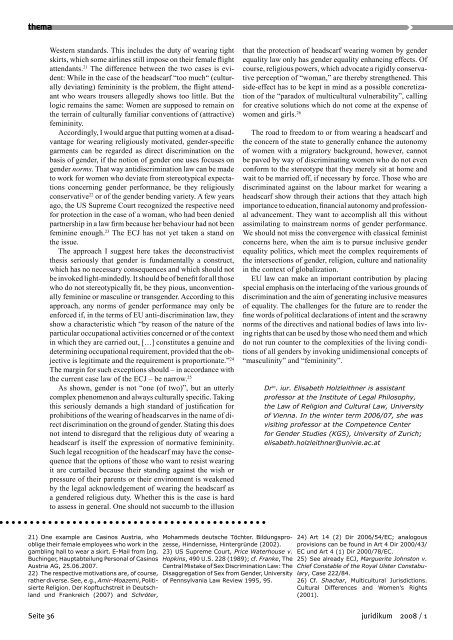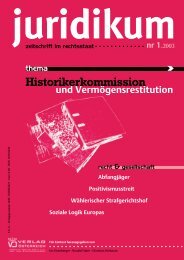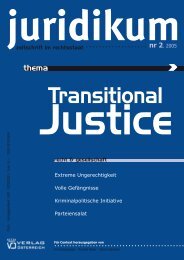Download - juridikum, zeitschrift für kritik | recht | gesellschaft
Download - juridikum, zeitschrift für kritik | recht | gesellschaft
Download - juridikum, zeitschrift für kritik | recht | gesellschaft
Erfolgreiche ePaper selbst erstellen
Machen Sie aus Ihren PDF Publikationen ein blätterbares Flipbook mit unserer einzigartigen Google optimierten e-Paper Software.
thema<br />
Western standards. This includes the duty of wearing tight<br />
skirts, which some airlines still impose on their female flight<br />
attendants. 21 The difference between the two cases is evident:<br />
While in the case of the headscarf “too much“ (culturally<br />
deviating) femininity is the problem, the flight attendant<br />
who wears trousers allegedly shows too little. But the<br />
logic remains the same: Women are supposed to remain on<br />
the terrain of culturally familiar conventions of (attractive)<br />
femininity.<br />
Accordingly, I would argue that putting women at a disadvantage<br />
for wearing religiously motivated, gender-specific<br />
garments can be regarded as direct discrimination on the<br />
basis of gender, if the notion of gender one uses focuses on<br />
gender norms. That way antidiscrimination law can be made<br />
to work for women who deviate from stereotypical expectations<br />
concerning gender performance, be they religiously<br />
conservative 22 or of the gender bending variety. A few years<br />
ago, the US Supreme Court recognized the respective need<br />
for protection in the case of a woman, who had been denied<br />
partnership in a law firm because her behaviour had not been<br />
feminine enough. 23 The ECJ has not yet taken a stand on<br />
the issue.<br />
The approach I suggest here takes the deconstructivist<br />
thesis seriously that gender is fundamentally a construct,<br />
which has no necessary consequences and which should not<br />
be invoked light-mindedly. It should be of benefit for all those<br />
who do not stereotypically fit, be they pious, unconventionally<br />
feminine or masculine or transgender. According to this<br />
approach, any norms of gender performance may only be<br />
enforced if, in the terms of EU anti-discrimination law, they<br />
show a characteristic which “by reason of the nature of the<br />
particular occupational activities concerned or of the context<br />
in which they are carried out, […] constitutes a genuine and<br />
determining occupational requirement, provided that the objective<br />
is legitimate and the requirement is proportionate.” 24<br />
The margin for such exceptions should – in accordance with<br />
the current case law of the ECJ – be narrow. 25<br />
As shown, gender is not “one (of two)”, but an utterly<br />
complex phenomenon and always culturally specific. Taking<br />
this seriously demands a high standard of justification for<br />
prohibitions of the wearing of headscarves in the name of direct<br />
discrimination on the ground of gender. Stating this does<br />
not intend to disregard that the religious duty of wearing a<br />
headscarf is itself the expression of normative femininity.<br />
Such legal recognition of the headscarf may have the consequence<br />
that the options of those who want to resist wearing<br />
it are curtailed because their standing against the wish or<br />
pressure of their parents or their environment is weakened<br />
by the legal acknowledgement of wearing the headscarf as<br />
a gendered religious duty. Whether this is the case is hard<br />
to assess in general. One should not succumb to the illusion<br />
that the protection of headscarf wearing women by gender<br />
equality law only has gender equality enhancing effects. Of<br />
course, religious powers, which advocate a rigidly conservative<br />
perception of “woman,” are thereby strengthened. This<br />
side-effect has to be kept in mind as a possible concretization<br />
of the “paradox of multicultural vulnerability”, calling<br />
for creative solutions which do not come at the expense of<br />
women and girls. 26<br />
The road to freedom to or from wearing a headscarf and<br />
the concern of the state to generally enhance the autonomy<br />
of women with a migratory background, however, cannot<br />
be paved by way of discriminating women who do not even<br />
conform to the stereotype that they merely sit at home and<br />
wait to be married off, if necessary by force. Those who are<br />
discriminated against on the labour market for wearing a<br />
headscarf show through their actions that they attach high<br />
importance to education, financial autonomy and professional<br />
advancement. They want to accomplish all this without<br />
assimilating to mainstream norms of gender performance.<br />
We should not miss the convergence with classical feminist<br />
concerns here, when the aim is to pursue inclusive gender<br />
equality politics, which meet the complex requirements of<br />
the intersections of gender, religion, culture and nationality<br />
in the context of globalization.<br />
EU law can make an important contribution by placing<br />
special emphasis on the interlacing of the various grounds of<br />
discrimination and the aim of generating inclusive measures<br />
of equality. The challenges for the future are to render the<br />
fine words of political declarations of intent and the scrawny<br />
norms of the directives and national bodies of laws into living<br />
rights that can be used by those who need them and which<br />
do not run counter to the complexities of the living conditions<br />
of all genders by invoking unidimensional concepts of<br />
“masculinity” and “femininity”.<br />
Dr in . iur. Elisabeth Holzleithner is assistant<br />
professor at the Institute of Legal Philosophy,<br />
the Law of Religion and Cultural Law, University<br />
of Vienna. In the winter term 2006/07, she was<br />
visiting professor at the Competence Center<br />
for Gender Studies (KGS), University of Zurich;<br />
elisabeth.holzleithner@univie.ac.at<br />
21) One example are Casinos Austria, who<br />
oblige their female employees who work in the<br />
gambling hall to wear a skirt. E-Mail from Ing.<br />
Buchinger, Hauptabteilung Personal of Casinos<br />
Austria AG, 25.06.2007.<br />
22) The respective motivations are, of course,<br />
rather diverse. See, e.g., Amir-Moazemi, Politisierte<br />
Religion. Der Kopftuchstreit in Deutschland<br />
und Frankreich (2007) and Schröter,<br />
Mohammeds deutsche Töchter. Bildungsprozesse,<br />
Hindernisse, Hintergründe (2002).<br />
23) US Supreme Court, Price Waterhouse v.<br />
Hopkins, 490 U.S. 228 (1989); cf. Franke, The<br />
Central Mistake of Sex Discrimination Law: The<br />
Disaggregation of Sex from Gender, University<br />
of Pennsylvania Law Review 1995, 95.<br />
24) Art 14 (2) Dir 2006/54/EC; analogous<br />
provisions can be found in Art 4 Dir 2000/43/<br />
EC und Art 4 (1) Dir 2000/78/EC.<br />
25) See already ECJ, Marguerite Johnston v.<br />
Chief Constable of the Royal Ulster Constabulary,<br />
Case 222/84.<br />
26) Cf. Shachar, Multicultural Jurisdictions.<br />
Cultural Differences and Women’s Rights<br />
(2001).<br />
Seite 36 <strong>juridikum</strong> 2008 / 1
















